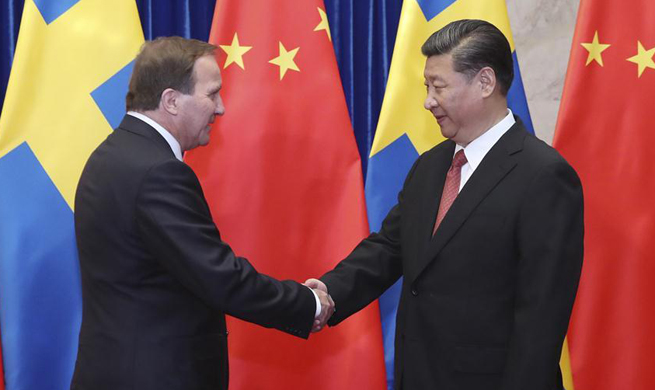by Shen Zhonghao
FRANKFURT,June 26 (Xinhua) -- The European Union (EU) enjoyed a positive momentum of economic recovery in the first half of this year amid headwinds stemming from both inside and outside the bloc, including Brexit, terrorist threats, the refugee crisis and geopolitical risks which remain persistent challenges for the EU's sustained growth and integration.
BROAD-BASED RECOVERY
The political and economic union currently consisting of 28 member states saw a quarterly gross domestic product (GDP) growth of 0.6 percent, as all member states, except Greece, have maintained positive economic growth for three consecutive quarters.
President of the European Central Bank (ECB) Mario Draghi said in April that the dispersion in growth rates across both sectors and countries had narrowed significantly and both were at their lowest level since 1997, reflecting that the recovery in Europe has evolved from being fragile and uneven into a firm, broad-based upswing.
The European Commission has twice revised upwards its projection of GDP growth in EU since the beginning of 2017. According to the latest forecast released in May, the EU economy is expected to grow by 1.9 percent both in 2017 and 2018.
"The European economy has entered its fifth year of recovery, which is now reaching all EU member states. This is expected to continue at a largely steady pace this year and next," the European Commission concluded in its spring economic forecast.
In particular, it is for the first time in almost a decade that the economies of all EU member states are expected to grow throughout the entire period from 2016 to 2018.
GROWTH MAINLY DRIVEN BY DOMESTIC DEMAND
The world economy has shown positive signs of stabilization and recovery this year, particularly the steady growth observed in major economies, creating a better export market for the EU compared with previous year.
During the first four months of 2017, EU member states exported goods worth 607 billion euros (680 billion U.S. dollars) to the rest of the world, recording a year-on-year increase of nine percent. Meanwhile, imports have grown by 10 percent.
Compared with foreign trade, private consumption has been playing a more significant role in stimulating EU economic growth in the context of sustained improving labor markets in Europe and the increase in employees' nominal income.
In April, the EU unemployment rate fell to 7.8 percent, the lowest level since December 2008, thanks to the employment of young people under the age of 25 which has significantly improved.
The average unemployment rate in the EU could be around eight percent in 2017 and would further decline to 7.7 percent next year, according EU estimates.
In the past, growth in euro area, the core of the EU, has been closely interdependent with world trade, with external demand playing a central role in supporting recoveries after the dotcom crash and the Lehman bankruptcy, Draghi reminded.
World trade has weakened considerably since mid-2014, Draghi said, while the correlation with euro area output has more or less broken down. "Growth has accelerated even as world trade has fallen back."
UNCERTAINTIES AND CHALLENGES REMAIN
In spite of the encouraging positive signs of growth, uncertainty surrounding the EU economic outlook remains elevated.
"The risks surrounding the eurozone growth outlook, while moving to a more balanced configuration, are still tilted to the downside and relate predominantly to global factors," the ECB head said in April.
External risks are linked, for instance, to future U.S. economic and trade policy and broader geopolitical tensions.
Moreover, in order to keep EU economic growth strong, balanced and sustainable, challenges within Europe itself should be addressed and further structural reforms implemented even more ambitiously.
Firstly, the ECB is expected to withdraw money stimulus, on which the growth of 19 member states in the euro area has been dramatically dependent for several years. Investors at financial markets anticipate clearer signals unveiled by the ECB in the second half of this year, as the underlying inflation rate continues to rebound, however slowly.
A less accommodating monetary policy could lead to discomfort in the euro area, especially in periphery countries like Greece, on account of less favorable lending conditions which will make economic structural adjustments more difficult.
Secondly, lots of negotiations over Brexit between EU and Britain await. Since the Conservative Party led by British Prime Minister Theresa May lost its majority in British parliamentary elections in early June, the situation has become increasingly ambiguous.
Observers said British voters are concerned about May's "hard Brexit" approach of leaving the EU's single market and imposing restrictions on immigration.
The Organisation for Economic Cooperation and Development (OECD) predicted that the British economy would slow down next year because of the uncertainty created by the Brexit negotiations.
However, to what extent Brexit would practically affect EU economic growth remains unclear. As the negotiations advance, the financial sector and real economic sector in the EU would respond, for example, by further relocating their business.
In addition, the EU still faces massive challenges in deepening structural reforms both at the EU and national level, which is considered the only way to lead cyclical recovery to structural recovery in Europe.
"We need to ensure convergence between member states towards more resilient economic structures. The bulk of economic and social policies is and will remain at the national level, and there is no doubt that we need a continuous commitment to structural reforms," EU Vice-President for the Euro and Social Dialogue Valdis Dombrovskis said.

















